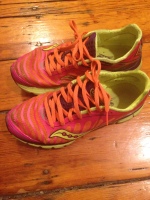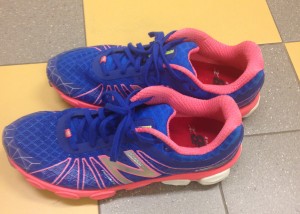After probably far too many miles logged on my old ones, I made time in my weekend to take a trip to Marathon Sports to invest in a new pair of running shoes. From what I’ve found, the general rule of thumb is to retire running shoes after you’ve ran anywhere from 200-400 miles in them. Running surfaces can factor into that range, and with the brutal winter we’re still having, my Saucony Kinvara 3s had taken a beating.

It was time for these guys to retire.
Marathon Sports is located at the finish line on Boylston Street and serves as a mecca for the Boston Marathon. The storefront window holds a countdown, down to the second of the start time on April 21st. As a first-time marathoner, it felt like a rite of passage that I purchase my race-day shoes from them.
Apparently, everyone else had the same idea. The place was PACKED. But it was awesome. So many runners, some repeat Boston participants and some just starting out in their running journeys, were there to get expert advice on everything from shoes to course training. It definitely got me even more pumped to be a part of such an awesome event.

26 days, 1 hour, 36 minutes, and 43 seconds to the official start time.
I’m notorious for over-analyzing when it comes to making decisions. Normally this purchase would have been a huge a deal. I would have tried on pair after pair of sneakers, as if they might be the magical reason behind my marathon performance. Should I stick with the same brand? Are these going to be too tight across my foot? Do I like this color?
Instead, this time I told the guy helping me that I was looking for the same minimalist shoe build as the Kinvara 3s but with more cushion. He quickly recommended three different shoes, all different brands, and brought them out for me to try. At Marathon Sports, just about all of the employees are runners themselves, and trained in evaluating the best shoe for a runner’s gate and mechanics. If your new to the sport, or just want an evaluation, they will watch you run to determine if you over-pronate, under-pronate, or have a neutral gate.

Nothing like a new pair of shoes for motivation!
After taking each pair for a spin on the sidewalk, I settled on a pair of New Balance 890v4s. They were by far the most comfortable while still encouraging a mid-foot strike. I naturally run with my heel striking the surface first, which can cause knee pain, so I’ve been working to correct that.
As for my quick and painless decision, I think I just knew that no properly chosen shoe is going to make or break my marathon experience. I am in total control of how race day goes for me, and that starts with my training, strength-training, and nutritional choices.








